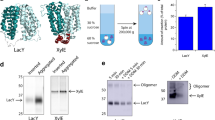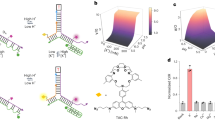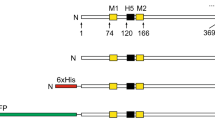Abstract
THE functional activity of ion channels and other membrane proteins requires that the proteins be correctly assembled in a transmembrane configuration. Thus, the functional expression of ion channels, neurotransmitter receptors and complex membrane-limited signalling mechanisms from complementary DNA has required the injection of messenger RNA or transfection of DNA into Xenopus oocytes or other target cells that are capable of processing newly translated protein into the surface membrane1–4. These approaches, combined with voltage-clamp analysis of ion channel currents, have been especially powerful in the identification of structure–function relationships in ion channels5–7. But oocytes express endogenous ion channels8,9, neurotransmitter receptors10 and receptor–channel subunits11, complicating the interpretation of results in mRNA-injected eggs. Furthermore, it is difficult to control experimentally the membrane lipids and post-translational modifications that underlie the regulation and modulation of ion channels in intact cells. A cell-free system for ion channel expression is ideal for good experimental control of protein expression and modulatory processes. Here we combine cell-free protein translation, microsomal membrane processing12–14 of nascent channel proteins, and reconstitution of newly synthesized ion channels into planar lipid bilayers15 to synthesize, glycosylate, process into membranes, and record in vitro the activity of functional Shaker potassium channels.
This is a preview of subscription content, access via your institution
Access options
Subscribe to this journal
Receive 51 print issues and online access
$199.00 per year
only $3.90 per issue
Buy this article
- Purchase on Springer Link
- Instant access to full article PDF
Prices may be subject to local taxes which are calculated during checkout
Similar content being viewed by others
References
Lester, H. A. Science 241, 1057–1063 (1988).
Perez-Reyes, E. et al. Nature 340, 233–236 (1989).
Klaiber, K. et al. Neuron 5, 221–226 (1990).
Yang, X.-C. et al. J. Neurosci. 12, 268–277 (1992).
Numa, S. Harvey Lect. 83, 121–165 (1989).
Guy, H. R. & Conti, F. Trends Neuro. 13, 201–206 (1990).
Miller, C. Science 252, 1092–1096 (1991).
Dascal, N. CRC crit Rev. Biochem. 22, 318–387 (1987).
Bourinet, E., Fournier, F., Nargeot, J. & Charnet, P. FEBS Lett. 299, 5–9 (1992).
Fluharty, S. J., Reagan, L. P. & White, M. M. J. Neurochem. 56, 1307–1311 (1991).
Buller, A. L. & White, M. M. Molec. Pharmac. 37, 423–428 (1990).
Walter, P. & Blobel, G. Meth. Enzym. 96, 84–93 (1983).
Walter, P., Gilmore, R. & Blobel, G. Cell 38, 5–8 (1984).
Kobilka, B. K. J. biol. Chem. 265, 7610–7618 (1990).
Miller, C. Ion Channel Reconstitution (Plenum, New York, 1986).
Yellen, G., Jurman, M. E., Abramson, T. & MacKinnon, R. Science 251, 939–942 (1991).
Kamb, A., Tseng-Crank, J. & Tanouye, M. A. Neuron 1, 421–430 (1988).
Hoshi, T., Zagotta, W. N. & Aldrich, R. W. Science 250, 533–538 (1990).
Das, R. C., Brinkley, S. A. & Heath, E. C. J. biol. Chem. 255, 7933–7940 (1980).
Hoshi, T., Zagotta, W. N. & Aldrich, R. W. Neuron 7, 547–556 (1991).
Iverson, L. E., Tanouye, M. A., Lester, H. A., Davidson, M. & Rudy, B. Proc. natn. Acad. Sci. U.S.A. 85, 5723–5727 (1988).
MacKinnon, R. Nature 350, 232–235 (1991).
Alberts, B. et al. Molecular Biology of the Cell 2nd edn (Garland, New York, 1991).
Zona, C., Eusebi, F. & Miledi, R. Proc. R. Soc. B239, 119–127 (1990).
Segev, N. Science 252, 1553–1556 (1991).
Hille, B. Ionic Channels of Excitable Membranes 2nd edn (Sinauer, Sunderland, Massachusetts, 1992).
Schwartz, T. L., Tempel, B. L., Papazian, D. M., Jan, Y. N. & Jan, L. Y. Nature 331, 137–142 (1988).
Schwartz, T. L., Papazian, D. M., Carretto, R. C., Jan, Y.-N. & Jan, L. Y. Neuron 2, 119–127 (1990).
Maley, F., Trimble, R. B., Tarentino, A. L. & Plummer, T. H. Jr Analyt. Biochem. 180, 195–204 (1989).
Rosenberg, R. L. & Chen, X.-h. J. gen. Physiol. 97, 1207–1225 (1991).
Author information
Authors and Affiliations
Rights and permissions
About this article
Cite this article
Rosenberg, R., East, J. Cell-free expression of functional Shaker potassium channels. Nature 360, 166–169 (1992). https://doi.org/10.1038/360166a0
Received:
Accepted:
Issue Date:
DOI: https://doi.org/10.1038/360166a0
This article is cited by
-
Function of Shaker potassium channels produced by cell-free translation upon injection into Xenopus oocytes
Scientific Reports (2013)
-
Translation of ‘rare’ Codons in a Cell-free Protein Synthesis System from Escherichia coli
Journal of Structural and Functional Genomics (2006)
-
A truncated Kv1.1 protein in the brain of the megencephalymouse: expression and interaction
BMC Neuroscience (2005)
Comments
By submitting a comment you agree to abide by our Terms and Community Guidelines. If you find something abusive or that does not comply with our terms or guidelines please flag it as inappropriate.



